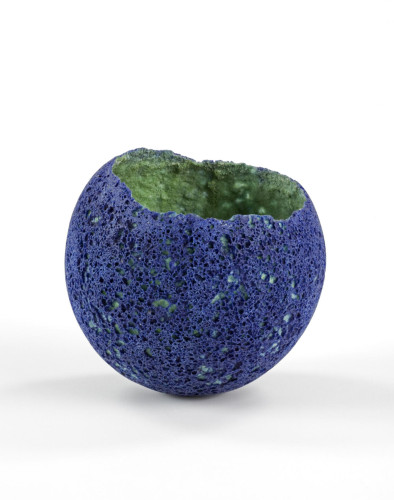40/1999
Collection
Glass
Brief description
Vase made from crushed, fired and polished recycled glass, with a pitted blue surface and green interior, made by Emma O'Dare in London in 1998.
Object name
vase
vase
vase
Object number
40/1999
Production person
Emma O'Dare (designer)
Emma O'Dare (maker)
Emma O'Dare (maker)
Production date
1998 (made)
Production place
London (made)
Period
Twentieth century (1900-1999)
Material
glass
cobalt oxide
chrome oxide
wallpaper paste
cobalt oxide
chrome oxide
wallpaper paste
Technique
crushed
fired
polished
fired
polished
Physical description
Vase or vessel of part spherical form, the rim or aperture formed by a jagged edge, designed and made by Emma O'Dare in 1998. The outer surface is of pitted blue glass allowing the inner surface, which is coloured green, to show through. The surface has a volcanic quality, reminicent of pumice or sponge. The piece was produced by crushing recycled glass to a sugar-like consistency and mixing with ceramic oxides (producing the colours) and wallpaper paste. The mixture was painted onto a plaster mould and fired in a kiln. It was then polished. Emma O'Dare makes these pieces in series, selling direct from the studio and at craft fairs.
Dimensions
Height: 12.5cm
Diameter: 13.5cm
Diameter: 13.5cm
Website keywords
Decoration and furnishings
ornaments
ornaments
Label
Caption for Exploring 20th Century London website:
When the museum bought this vase, made by Emma O'Dare from crushed recycled glass, in 1998, we contacted some of her customers who had bought similar pieces to ask how they displayed them in their homes. One woman living in Islington, a sculptor herself, had been drawn to the vase by the way the light shone through the pitted surface, and though it didn't have one stationary location in her home, she was keeping it at that time in front of a stained glass window in her hall, to catch its translucence as the coloured light filtered through it.
When the museum bought this vase, made by Emma O'Dare from crushed recycled glass, in 1998, we contacted some of her customers who had bought similar pieces to ask how they displayed them in their homes. One woman living in Islington, a sculptor herself, had been drawn to the vase by the way the light shone through the pitted surface, and though it didn't have one stationary location in her home, she was keeping it at that time in front of a stained glass window in her hall, to catch its translucence as the coloured light filtered through it.




